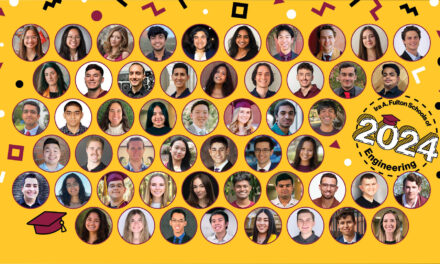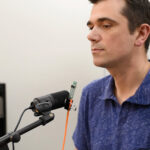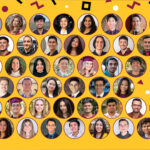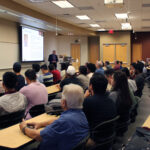
EPICS teams advance projects through COVID-safe eSpaces

Above: Arizona State University students Rajat Arora (left) and Nadia Jafar (right) work together in the eSpaces to prototype the hardware component of their Engineering Projects in Community Service, or EPICS project, which is a refreshable Braille display that can transcribe text on the screen into physical Braille. The team is working with Bridge2Africa, a Johannesburg nonprofit whose goal is to use technology to assist various communities around South Africa. Photographer: Connor McKee/ASU
Engineers design solutions to help solve a variety of problems facing modern-day society. That’s the key goal of the Engineering Projects in Community Service program in the Ira A. Fulton Schools of Engineering at Arizona State University known as EPICS, where student teams work together to design solutions that have real-world impact for local and global communities.
With the onset of the COVID-19 pandemic and the transition to virtual learning, the project-based course had to find ways to advance projects with minimal in-person interaction.
“EPICS hasn’t been running quite the same way due to the pandemic,” says Mark Huerta, a lecturer in the Fulton Schools as well as the co-founder and chairman of 33 Buckets, a nonprofit organization that started as an EPICS project at ASU.
“We had to convert all our EPICS meetings from in person to Zoom last March,” he says. “And we carried that over to the fall semester with one major difference: the eSpaces were open.”
The eSpaces — hands-on learning and design studios for students — operate under a reservation policy. Teams are required to fill out a Google form to reserve a space, and this form then has to be approved by one of the undergraduate teaching assistants. When teams are working in the eSpaces, they must wear masks, socially distance and sanitize their workspaces as well as all of the tools they use as part of the prototyping process.
“We’ve had a lot of teams use that opportunity to meet in person, advance their projects and work on prototyping,” Huerta says.
Before the eSpaces were available, teams had to focus on advancing their projects virtually. In some cases, this means working on software components, but for other projects it means spending more time perfecting design in preparation for when they would be able to prototype.
EPICS teams will still meet primarily via Zoom this semester, but they’ll have the opportunity to use the eSpaces on campus for prototyping so long as they follow safety protocols
Whether students are participating remotely or in person at the eSpaces, they can be an active part of the prototyping process, a crucial step in taking solutions from conceptual designs to something that can be implemented in the community.
“Every student has their own situation and circumstance, and some are more comfortable coming in than others, so we try to make those accommodations,” Huerta says. “Sometimes you’ll see teams in the eSpaces on Zoom as well so they can include their team members who are not able to be there in person.”
Prototyping for better healthcare
Many EPICS teams have been able to improve their designs virtually over the past two semesters of distance learning, and they are now starting to move into the prototyping stage with the COVID-safe eSpaces.
“I am working on the Mayo Clinic Radiology Zipper Team, and our goal is to provide the Mayo Clinic with a wheelchair that allows patients to receive chest X-rays without having to stand up and risk injury,” says Krissian Hargreaves, a junior studying biomedical engineering. “In Fall 2020, our team worked on creating a full, working prototype and we are close to achieving that goal.”
Hargreaves says she is hopeful to complete the prototype this semester and give it to Mayo Clinic for feedback so they can adjust and improve the model.
“One advantage we have is that we are a small team, so it is easier to limit who we come into contact with,” Hargreaves says. “We are also able to hop on Zoom rather than going in person if we feel that we’ve been exposed or if we are not feeling well. Flexibility is key.”
The team is working on implementing a zipper to remove the backing of the wheelchair so that it does not block the X-ray scan and add a headrest to physically support the patient if needed.
“My team has made tremendous progress during the pandemic, so I am excited to see how far we can go moving forward,” Hargreaves says.
Using hardware and software to help students who are visually impaired
“Our EPICS team is working with Bridge2Africa, a nonprofit based in Johannesburg whose goal is to use technology to assist various communities around South Africa,” says Rajat Arora, a graduate student studying electrical engineering. “We are helping create a holistic system that allows students who are visually impaired to navigate the internet using Braille.”
The team’s solution involves both software and hardware. The hardware component is a refreshable Braille display that can transcribe text on the screen into physical Braille, while the software backend component works with existing screen readers to transmit information to the display and provide accessibility tools for users who are visually impaired.
“In Fall 2020, faced with the change in class modality, we had to change how we were doing our work and our priorities,” Arora says. “We made significant progress during the semester on our software, making it much easier to deploy. We also greatly improved our accessibility tools thanks to the work done by my team members Adriane Inocencio and Nadia Jafar. On the hardware side, we focused on improving our designs, getting us one step closer to scaling larger. We also improved the physical housing of the mechanisms due to the hard work of Connor Paul and Arnold Dates.”
The team now plans to finalize their product and produce a proof of concept that can be tested by students who are visually impaired.
With the need for physical prototyping, the team is taking every precaution to ensure they are staying safe while still being able to advance their project.
“We were able to stay safe several ways this semester,” Arora says. “Firstly, we utilized the eSpaces as our main mode of conducting prototyping, where it was previously done in public places like in the Barrett, the Honors College Academic Complex. Secondly, we utilized the free COVID-19 saliva testing offered to students by ASU, and had every member get tested once a week so when we were meeting in person we could be safe.”
Adaptability has been key for the team in achieving their goals.
“By doing more of our work online and following safety guidelines implemented in the eSpaces, everyone in our team managed to stay healthy and safe.”



































